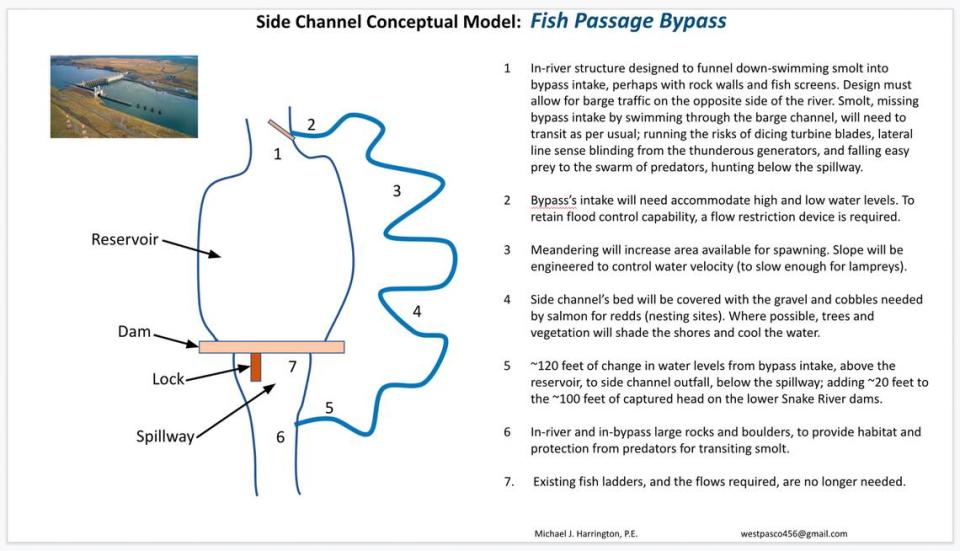What if there was another possibility in WA’s Snake River dam debate? | Opinion
Some people want the lower Snake River dams to go, others want to keep them.
The driving force behind ‘the dams must go’ is to help restore salmon populations and return the river to a natural condition. Deconstructing the dams would eliminate the reservoirs where:
▪ farm fertilizer is concentrated from runoff;
▪ the water is warmed and oxygen is depleted in these slow-moving sections; and
▪ a potential for toxic algae blooms exists.
Eliminating the actual dams would remove:
▪ impediments to upstream travel by spawning salmon;
▪ the danger smolt being diced by turbine blades;
▪ having the smolt’s lateral line sense blinded by the thunderous underwater pounding from the turbines; and avoid the swarm of young salmon predators concentrated below the spillway (evidenced by the bounty Washington State has put on squawfish).
‘Keep the dams’ folks value:
▪ flood control,
▪ barge transportation,
▪ irrigation water, and
▪ reliable, carbon-free energy.
This controversy is another polarizing issue.
In 2023, the largest dam removal project in history will begin; taking out four dams on the Klamath River.
What if there is a third possibility:
▪ to maintain all the benefits the dams provide;
▪ better facilitate fish passage in both directions; and
▪ actually increase available salmon spawning grounds?
Proposed is the construction of a side channel — a reservoir/dam bypass designed for fish passage.
Initially, a thorough feasibility study (an assessment of the practicality of a proposed plan) would be required.
We currently have very accurate topographical and geographical maps, that could be used to preliminarily plot the bypass route.

We don’t want to construct this only to see the water disappear into a layer of sand. Many new geological borings would be essential for evaluation. Where the cut is above the nearby ground water level, the unlined bypass will lose water. Conversely, where the bottom of cut is below the local water table, the side channel will gain water, possibly requiring sheet-pile walls and dewatering during construction, and lowering the water level in nearby wells long term.
A large pile of extracted material would require disposal. However, large rocks and boulders could be segregated and stockpiled, for eventual return into the side channel. Similarly, gravel and cobbles could be screened out to serve as the bedding material that salmon require for their redds. The resultant clean fill dirt may have a commercial value that exceeds transportation costs.
Many other questions would need answering in the feasibility study, before any earth is moved.
Initially, the feasibility study should not be written for all four lower Snake River dams — just one; for addressing site-specific design and construction challenges. Ice Harbor may be the easiest.
Bypass construction would be very expensive.
The Bonneville Power Administration, owner of these dams, may be responsible for the costs. However, these costs would have to be passed on to consumers; through higher electricity rates.
In cost contrast, if the BPA is hit with the one-two punch of losing a significant source of the product it sells, and must also cover the several billions of cost for dam removal (including several decades of accumulated sediment), then it is very likely that the Pacific Northwest will no longer enjoy some of the lowest electricity rates in the nation.
Other anticipated major challenges to bypass construction include:
▪ the Environmental Impact Statement;
▪ new designs for large-scale fish screens may be needed;
▪ farm land might be taken out of production;
▪ expensive litigation, should reluctant land owners resist ‘Eminent Domain’; and
▪ power lines, roads, pipes, bridges, and other infrastructures may require relocation.
Existing fish passages would no longer require water. However, the flow needed by the bypass would require more water than the current fish ladders. This water would not be available for energy production.
I believe this project is well within the capability of the United States Army Corps of Engineers.
Besides facilitating salmon passage, their opportunities and benefits would arise:
▪ Local economies would experience a construction boom and a long-term tourist attraction;
▪ The side channel could create some fantastic fishing spots; and
▪ There may be locations conducive to excavating broad, deep pools; swimming holes in a park-like setting.
Imagine… our being able to swim in cool, clear water — surrounded by shiny silver salmon.
Michael Harrington, of Pasco, is a former Fisheries Engineer that has retired from the United States Army Corps of Engineers, after supporting the DOE in its Hanford mission for over ten years.

